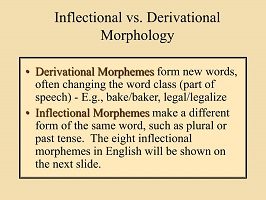Derivational morphemes types characteristics with examples
Derivational morphemes
The derivational morphemes are those particles that are added to a root word or words derived lexeme to form. A morpheme is the smallest unit of language with its own meaning. It cannot be divided into smaller lexical (with semantic content) or grammatical (with syntactic content) meaning units. In this article we will provide you information of derivational morphemes with examples.
In the case of derivational morphemes, these are combined to generate complex words. These types of words have a series of components known as roots and affixes.
The root is the basic (constant) part of the signifier of the word. Affixes are the elements that are attached to roots, modifying their meaning by forming new terms.
The process of mixing lexemes or roots with derivational morphemes is known as derivation. For example, the derivations hope, hope, hopelessness, and hopeless have as a common element “hope” which is the root. Meanwhile, the rest of the components of the word (anza, des, ado), represent the derivational morphemes.
It is important to note that derivational morphemes do not indicate gender, number, person, time or mode of the new words created. They limit themselves to intervening in the derivation and, in many cases, changing the grammatical category of the new terms.
Its process is the most productive in the Spanish language because it translates into an expansion of vocabulary.
Types and their characteristics
-Prefixes
Prefixes are those elements with a semantic value that precedes the root or another prefix. The derivational process of creating new words using this type of morpheme is known as prefixation. In Spanish, these come from Latin and Greek.
Prefixes can be negative, locative, temporal, quantitative, and intensifying. The negatives indicate deprivation or annoyance, the locative spatial relation as remoteness, and the temporal relation as posteriority. Meanwhile, the quantitative ones express an idea of quantity or size and the intensifiers, excess or pre-eminence.
There are many prefixes that are part of the language. Among other derivational morphemes of this class, we can mention a (negation), bi (two), circum (around), against (opposition), infra (below), inter (between), pre (prior) and pro ( in front of).
On the other hand, there are some Latin prefixes in Spanish that are no longer considered as such. The reason for this is that they have lost their ability to freely combine with other words. They can be mentioned within this group: abs (separation), ad (closeness), es (outside or deprivation) and / or (annoyance).
Examples
Below are the derivational morphemes with examples.
- Ante (before): antecedent, anterior, forearm, anterior.
- Anti (against): unethical, unsightly, contraception.
- Auto (auto): self-service, self-control, automobile.
- Bi (two): bicameral, bilateral, bi-monthly, bilingual.
- Cent (one hundred): centimeter, centenary.
- Against (against): counterproposal, counterweight, time trial, counter.
- With or com (with): concept, set, compassion.
- Des (undo, decrease): unfold, undo, undo, uncover.
- Between (between): intertwine, entertain, ajar.
- Former (foreign): ex-combatant, exporter, ex-spouse.
- Hyper: hypercaloric, hypertensive, hyperactive.
- Homo (equal): homograph, homosexual, homogeneous.
- Im, in (opposite): inescapable, essential, indestructible
- Inter (between, between): interpretation, interrupt, interpose.
- Mal (bad): mistreat, malpensado (malicious), malvivir (live badly).
- Monkey (one): monotonous, skateboard, monorail.
- Para (together, with, para): paramedic, paramilitary, paranormal.
- Poly (many): polyglot, versatile, polygamy.
- Pre (before): planned, pre-assembled, prehistoric.
- Re (again, with intensity): retry, rebirth, re-release.
- Semi (medium): crescent, demigod, semi-solid.
- Pseudo (false): pseudoscience, pseudoscientist.
- Over (excessive, extraordinary): cope, overcome, overexcite.
- Sub (below): underground, underworld, subnourish.
- Super (top): superconducting, superlative, superfuel.
- Tele (remote): telekinesis, telecontrol, telemetry.
- Uni (one): unicameral, unipolar, univalent.
-Suffixes
Suffixes are affixes that are placed after the root or another suffix. They can create new words by combining grammatical categories (nouns, verbs, and adjectives ). Each of these categories has its own group of suffixes to combine.
Suffixes can in turn be aspectual and appreciative. Aspectuals are divided into nominals (nouns), adjectives (adjectives) and verbs (verbs).
While the appreciatives can be diminutive (appreciation or sympathy), augmentatives (excess, mockery), derogatory (repulsion, mockery) and superlatives (maximum intensity).
Thus, for example, among the suffixes that can be used to form adjectives are: bundo (intensity), ble (capacity) and al (belonging or relative). Similarly, nouns can be created using the suffixes aje (action or place), tion (action) and anza (action, effect or position).
Examples
- Aryan (place, agent): sanctuary, herbalist, businessman, librarian.
- Phobia (fear of): claustrophobia, arachnophobia.
- Gram (written): cardiogram, encephalogram, numbergram.
- Ism (system, doctrine): Islamism, journalism, conformity.
- Ico-ica (related to science): trigonometric, logical.
- Sis (action, operation, generalization): acidosis, nucleosis, thrombosis.
- Ology (study of): ophthalmology, physiology, bacteriology.
- Ina (diminutives): little girl.
- Type (printed): logo,
- Tomía (cut): lobotomy, mastectomy.
- Ucho (derogatory): hotelucho, rag.
-Circumfixes
They are affixes that surround the root. They are known as discontinuous because they are combinations of prefixes and suffixes that “wrap” the root. Circums are very particular cases of affixes. It occurs very rarely in most of the world’s languages.
Examples
In the Spanish language, there are cases that follow circumfixation processes. An example of this is found in the French word. This is generally composed of a-root-ar, the root being the French word. This structure is the proof of the passage from French to French through circumfixes.
The same case occurs in the des-root-ar structures to generate the term husking. Similarly, you can see this process in the structure in -lexema- ar is the basis for the generation by circumfixes of the word get dirty.
We hope you have understood the derivational morphemes with examples.
